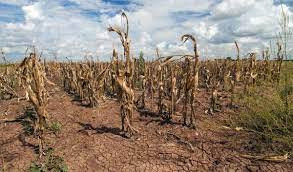
Climate change is no longer just an environmental issue; it has become a direct threat to global food security and human nutrition.
Rising temperatures, erratic weather patterns, and increased exposure to pests and diseases are putting immense pressure on agricultural systems.
These challenges not only reduce crop yields but also diminish the nutritional quality of staple foods, endangering the health of millions worldwide.
A particularly vulnerable group is the billions of smallholder farmers who depend on staple crops for both their livelihoods and sustenance.
They are responsible for producing one-third of the world’s food supply, yet they are the most affected by climate-induced disruptions.
If these trends continue unchecked, the ability to nourish a growing global population will become increasingly difficult.
Declining nutrient content in staple crops
Scientific research has revealed that higher atmospheric carbon dioxide (CO₂) levels and elevated temperatures contribute to a decline in the protein and micronutrient content of many crops.
Essential nutrients such as iron, zinc, and protein are expected to decrease by 3–17% due to these climate-induced changes.
The implications of this nutrient loss are alarming:
Zinc deficiency already affects 1.5 billion people worldwide, with projections estimating an additional 175 million individuals at risk as CO₂ levels rise.
Protein deficiency currently impacts 662 million people, and another 122 million could become protein deficient in the coming decades.
Iron deficiency—a major cause of anemia—could worsen for over a billion women and young children, leading to serious health consequences such as impaired cognitive development and weakened immune systems.
The populations most at risk are concentrated in South Asia, Southeast Asia, Africa, and the Middle East, where many communities already struggle with food insecurity.
These regions often lack the financial and technological resources needed to adapt to changing agricultural conditions.
Malnutrition and the global food system
Malnutrition is not just a consequence of climate change—it is also the result of weaknesses in global food systems.
Food production and distribution networks are failing to ensure adequate nutrition for vulnerable populations.
Emergency food systems in areas affected by climate disasters require urgent strengthening to prevent large-scale hunger crises.
While short-term solutions such as food aid and fortification of processed foods can help, they do not address the root causes of declining agricultural productivity and nutrient loss.
To ensure long-term food security and improved nutrition, innovative agricultural strategies are needed.
Biofortification: A promising solution
One of the most promising strategies for addressing climate-induced nutritional declines is biofortification—a process that enhances the nutrient content of crops through selective breeding and modern agricultural techniques.
Harvest Plus, a global leader in biofortification, has developed staple food crops with higher levels of iron, zinc, and vitamin A.
These crops are bred not only for enhanced nutrition but also for increased resilience to environmental stressors such as drought, heat, and pest infestations.
The potential of biofortification is immense:
It provides a sustainable, cost-effective solution for improving nutrition without requiring significant changes in dietary habits.
It enhances crop resilience against extreme weather conditions, reducing farmers’ vulnerability to climate change.
It contributes to food security by increasing yields and ensuring a stable supply of nutritious crops.
Biofortified millets, maize, and beans: Climate-resilient and nutritious
Several biofortified crops have already demonstrated remarkable potential in combating malnutrition and climate-related agricultural challenges.
Millets: The superfood for dry regions
Millets have been a staple food for low-income communities in arid regions of Africa and Asia for thousands of years.
Unlike many other crops, millet’s nutritional quality remains stable even under elevated CO₂ levels.
Pearl millet, in particular, has exceptional heat and drought tolerance, thriving in temperatures up to 42°C with minimal water requirements (<400 mm annual rainfall). When biofortified, it can provide up to 80% of an individual’s daily iron needs.
Finger millet has the highest calcium content among cereals, making it an excellent option for improving bone health.
Through selective breeding, its nutritional value can be further enhanced to support long-term health benefits.
Maize: A climate-smart staple crop
Maize is another critical food source that can be made more nutritious and climate-resilient through biofortification.
Provitamin A-enriched maize hybrids have been released in 11 countries. These varieties not only help combat vitamin A deficiency but are also highly resistant to heat stress (up to 45°C) and drought.
Zinc-rich maize varieties, developed from quality protein maize (QPM) germplasm, offer enhanced protein content and are proven to withstand tropical heat and high moisture levels.
These varieties are currently cultivated in countries such as Honduras, Guatemala, Colombia, El Salvador, and Nicaragua.
Iron-biofortified beans: A heat-tolerant protein source
Beans are a key source of protein and micronutrients for millions, particularly in Latin America and Africa. However, traditional bean varieties are sensitive to temperature increases.
Iron-biofortified beans, developed from Mesoamerican bean species, show high heat tolerance (up to 4°C above normal ranges).
Thirteen varieties have been released across Latin America, where they are helping communities combat iron deficiency and improve overall nutrition.
The future of food security: Scaling up biofortification
While biofortification offers a promising pathway to mitigate climate-induced malnutrition, its success depends on widespread adoption and investment.
Governments, research institutions, and agricultural organizations must work together to expand the reach of biofortified crops.
Key actions needed:
Increased funding for biofortification research to develop new crop varieties tailored to different climate conditions.
Strengthening seed distribution systems to ensure biofortified crops reach smallholder farmers in vulnerable regions. Raising awareness and promoting adoption among farmers and consumers to integrate bio fortified crops into daily diets.
Integrating biofortification into national food security policies to make nutrient-rich crops a cornerstone of agricultural development strategies.
Conclusion: A sustainable path forward
The climate crisis is reshaping global food systems, threatening agricultural productivity, and exacerbating malnutrition. However, innovative solutions like biofortification provide hope for a more resilient and nutritious future.
By harnessing genetic diversity and selective breeding, biofortified crops can play a crucial role in ensuring food security for millions.
Investing in biofortification today is not just an agricultural necessity—it is a moral imperative to protect the health and well-being of future generations.
*Gary Gerald Mtombeni is a journalist based in Harare. He writes here in his own personal capacity. For feedback Email garymtombeni@gmail.com/ call- +263778861608










